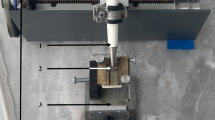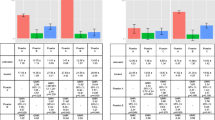Summary
This study compares the effect of 4 different air-powder abrasive devices (PWS) (Air-Flow®-S1, Clean-Jet®, Prophy-Jet® 30, Prophy-Unit®) on tooth enamel. Freshly extracted bovine teeth were partially embedded in polyurethane, the labial surface ground flat and highly polished. Subsequently the teeth were subjected to the spray from the air-powder abrasive device for 60 s or polished with a prophylactic paste (CCS® 170, CCS® 250 or Cleanic®) for the same length of time. The effects of the different air-powder abrasive systems were tested under multiple adjustments of powder/air and water. In addition the effects of air-powder abrasive systems and prophylactic pastes on several dentin surfaces were measured. The resulting surface textures of the teeth were examined using laser optic profilometry. In this process multiple measurements of roughness as well as tooth erosion were determined. The Clean-Jet® led to significantly rougher surfaces than the 3 prophylactic pastes at every setting. The Air-Flow®-S1, Prophy-Jet® 30 and Prophy-Unit® resulted in enamel abrasion that was either less than that caused by the prophylactic pastes or not significantly different at every examined setting. The 3 polishing pastes removed 3.6 μm to 7.2 μm of enamel in 60 s. The Clean-Jet® removed significantly more enamel at every setting per unit of time than the prophylactic pastes (up to 0.1 mm/min); therefore routine application of this device is not advised. Enamel abrasion by the Air-Flow®-S1, Prophy-Jet® 30 and Prophy-Unit® was either less than that measured with the prophylactic pastes or not significantly different. However, the Air-Flow®-S1 was more abrasive than Cleanic® paste at maximum water adjustment. The Air-Flow-S1® removed 641.2 μm/min of dentin compared to 339,6 μm/min by the Prophy-Jet® 30.
Zusammenfassung
Die vorliegende Arbeit vergleicht die Wirkungen vier verschiedener Pulver-Wasser-Strahlgeräte (PWS) (Air-Flow®-S1, Clean-Jet®, Prophy-Jet® 30, Prophy-Unit®) auf Zahnschmelz. Frisch extrahierte Rinderzähne wurden partiell in Kunststoff eingebettet, die Labialflächen plan geschliffen sowie hochglanzpoliert. Anschließend wurden die Zähne mit einem Pulver-Wasser-Strahlgerät für 60 s bestrahlt oder ebensolange mit einer Prophylaxepaste (CCS® 170, CCS® 250 oder Cleanic®) poliert. Die Wirkung der Pulver-Wasser-Strahlgeräte wurde bei einer Vielzahl unterschiedlicher Pulver/Luft- und Wasser-Einstellungen geprüft. Zusätzlich wurde die Wirkung von Pulver-Wasser-Strahlgeräten und Prophylaxepasten auf einige Dentinflächen gemessen. Die bearbeiteten Zahnoberflächen wurden laseroptisch profilometrisch untersucht. Dabei wurde neben mehreren Rauheitskenngrößen auch der Materialabtrag bestimmt. Das Clean-Jet®-Gerät führte bei allen Einstellungen zu signifikant rauheren Oberflächen als die drei Prophylaxepasten. Bei allen untersuchten Einstellungen erzeugten Air-Flow®-S1, Prophy-Jet® 30 und Prophy-Unit® Schmelzrauhigkeiten, die entweder geringer waren als nach Prophylaxepaste-Anwendung oder sich von deren Ergebnis nicht unterschieden. Die drei Polierpasten trugen binnen 60 s 3,6 μm bis 7,2 μm Schmelz ab. Das Clean-Jet®-Gerät trug in allen Einstellungen pro Zeiteinheit signifikant mehr Schmelz ab als die Prophylaxepasten (bis zu 0,1 mm/min), so daß von einer routinemäßigen Anwendung dieses Gerätes abzuraten ist. Der Schmelzverlust durch Air-Flow®-S1, Prophy-Jet® 30 und Prophy-Unit® war entweder geringer als mit den Prophylaxepasten gemessen oder unterschied sich von deren Ergebnis nicht. Das Air-Flow®-S1-Gerät war bei maximaler Wasser-Einstellung jedoch abrasiver als die Cleanic®-Paste. Auf Dentin trug das Air-Flow®-S1-Gerät in einer Minute 641,2 μm ab und das Prophy-Jet® 30-Gerät 339,6 μm.
Similar content being viewed by others
References
Arizumi K, Yamauchi M, Andoh M, Takigawa H, Uematsu K, Kawano J. A study on air-powder abrasive system for prosthetic clinical applications. Part 1. Characteristics of air-powder abrasive system and the effect of it on teeth surface J Jpn Prosthodont Soc 1987;31:267–75.
Axelsson P, Lindhe J. Effect of oral hygiene and professional tooth-cleaning on gingivitis and dental caries. Community Dent Oral Epidemiol 1981;9:251–5.
Axelsson P, Paulander J, Svärdström G, Tollskog G, Nordenstern G. Integrated caries prevention: effect of a needs-related preventive program on dental caries in children. County of Värmland, Sweden: results after 12 years. Caries Res 1993;27:Suppl 1:83–94.
Banek-Himpler MK. Die Auswirkungen von Pulverstrahlgeräten zur Zahnreinigung auf die Oberfläche von Zahnschmelz und Gingiva. Eine klinisch-experimentelle Untersuchung am Beispiel des Pulverstrahlgerätes Air-Flow der Firma EMS. Zahnmed Diss, Rheinisch-Westfälische Technische Hochschule, Aachen 1987.
Barnes CM, Russell CM, Gerbo LR, Wells BR, Barnes DW. Effects of an air-powder polishing system on orthodontically bracketed and banded teeth. Am J Orthod Dentofac Orthop 1990;97:74–81.
Bester SP, De Wet FA, Nel JC, Driessen CH. The effect of airborne particle abrasion on the dentin smear layer and dentin: an in vitro investigation. Int J Prosthod 1995;8:46–50.
Bishara SE, Fehr DE, Jakobsen JR. A comparative study of the debonding strengths of different ceramic brackets, enamel conditioners, and adhesives. Am J Orthod Dentofac Orthop 1993;104:170–9.
Bishara SE, Sulieman AH, Olson M. Effect of enamel bleaching on the bonding strength of orthodontic brackets. Am J Orthod Dentofac Orthop 1993;104:444–7.
De Boever JA, Vande Velde F. Pulverstrahlgeräte zur Belagsentfernung. Eine klinische und rasterelektronenmikroskopische Studie. Dtsch Zahnärztl Z 1985;40:725–9.
Eliades GC, Tzoutzas JG, Vougiouklakis GJ. Surface alterations on dental restorative materials subjected to an air-powder abrasive instrument. J Prosthet Dent 1991;65:27–33.
Galloway SE, Pashley DH. Rate of removal of root structure by the use of the prophy-jet device. J Periodontol 1987;58:464–9.
Gerbo LR, Barnes CM, Leinfelder KF. Applications of the air-powder polisher in clinical orthodontics. Am J Orthod Dentofac Orthop 1993;103:71–3.
Gerbo LR, Lacefield WR, Barnes CM, Russell CM. Enamel roughness after air-powder polishing. Am J Dent 1993;6:96–8.
Gutmann MS, Marker VA, Gutmann JL. Restoration surface roughness after air-powder polishing. Am J Dent 1993;6:99–102.
Hannemann M, Diedrich P. Der Einsatz des Prophy-Jet-Gerätes zur Schmelzpolitur nach der Bracketentfernung. Fortschr Kieferorthop 1986;47:317–26.
Heintze SD. Individualprophylaxe bei Multiband-Patienten (III). Quintessenz J 1994;24:417–23.
Heintze SD, Finke C, Jost-Brinkmann P.-G- Miethke R.-R.. Individualprophylaxe in der Kieferorthopädie. Quintessenz, Berlin, 1992.
Heiser W, Pfaller K. Die Anwendung des Air Flow® in der kieferorthopädischen Praxis. Inf Orthod Kieferorthop 1984;16:185–90.
Horning G. Clinical use of an air-powder abrasive. Compend Contin Educ Dent 1987;8:652–64.
Horning GM, Cobb CM, Killoy WJ. Effect of an air-powder abrasive system on root surfaces in periodontal surgery. J Clin Periodontol 1987;14:213–20.
Hosoya Y, Johnston JW. Evaluation of various cleaning and polishing methods on primary enamel. J Pedod 1989;13:253–69.
Huber SJ, Vernino AR, Nanda RS. Professional prophylaxis and its effect on the periodontium of full-banded orthodontic patients. Am J Orthod Dentofac Orthop 1987;91:321–7.
Hügelmeyer T. Oberflächenveränderung von Zahnschmelz, Wurzelzement, Amalgam und Kunststoff nach Behandlung mit verschiedenen Reinigungsinstrumenten. Quintessenz 1989;40:683–93.
Jost-Brinkmann P-G, Endt M, Miethke R-R. Fluoridfreisetzung von Komposit-Bracketklebern und-Fissurenversieglern unter dem Einfluß wiederholter Bearbeitung mit Pulver-Wasser-Strahlgeräten (PWS). Prophylaxe Impuls 1997;1: 118–27.
Jost-Brinkmann P-G, Miethke R-R, Gehrke T. Festsitzende kieferorthopädische Apparaturen und die Entwicklung von Karies, insbesondere Initialläsionen. Inf Orthod Kieferorthop 1996;28:327–36.
Jost-Brinkmann P-G, Schiller RA, Jost-Brinkmann B. Untersuchung zur Häufigkeit transitorischer Bakteriämien durch Zahnreinigung mittels Pulverstrahlgeräten. Quintessenz 1994;45:1677–87.
Klimek J, Prinz M, Hellwig E, Arends G. Effect of a preventive program based on professional toothcleaning and fluoride application on caries and gingivitis. Community Dent Oral Epidemiol 1985;13:295–8.
Kontturi-Närhi V, Markhanen S, Markhanen H. Effects of airpolishing on dental plaque removal and hard tissues as evaluated by scanning electron microscopy. J Periodontol 1990;61:334–8.
Kops C. Haftung von 16 zahnärztlichen Füllungskunststoffen am Rinderzahnschmelz sowie rasterelektronenmikroskopische Oberflächenuntersuchungen am Schmelz von Mensch und Rind. Zahnmed. Diss., FU Berlin, Berlin, 1979.
Kozlovsky A, Soldinger M, Sperling I. The effectiveness of the air-powder abrasive device on the tooth and periodontium: an overriew. Clin Prev Dent 1989;11:7–11.
Leckel M, Lenz P, Gilde H. Vergleich zweier Pulverstrahlsysteme zur Zahnreinigung. ZWR 1989;98:518–21.
Levinkind M, Vandernoot TJ, Elliott JC. Electrochemical impedance characterization of human and bovine enamel. J Dent Res 1990;69:1806–11.
Lubow RM, Cooley RL. Effect of air-powder abrasive instrument on restorative materials. J Prosthet Dent 1986;55:462–5.
Lutz F, Sener B, Imfeld T, Barbakow F, Schüpbach P. Self-adjusting abrasiveness: a new technology for prophylaxis pastes. Quintessence Int 1993;24:53–63.
Lutz F, Sener B, Imfeld T, Barbakow F, Schüpbach P. Comparison of the efficacy of prophylaxis pastes with conventional abrasives or a new self-adjusting abrasive. Quintessence Int 1993;24:193–201.
Mahlendorff M. Untersuchungen über Abrasion und Oberflächenveränderung auf Zahnschmelz nach Anwendung von Hilfsmitteln der mechanischen Belagentfernung: Vergleich von Gummikelch und Polierpaste mit den Abrasivstrahlern AIR-FLOW und PROPHY-JET. Zahnmed. Diss., Julius-Maximilians-Universität, Würzburg 1985.
Mahlendorff M. Beurteilung der Beziehungen von Abrasion und Oberflächenveränderung bei professioneller Zahnreinigung. Dtsch Zahnärztl Z 1989;44:203–4.
Manschot A. Orthodontics and inadequate oral hygiene compliance as a combined cause of localized gingival recession: a case report. (Abstract von: Quintessence Int. 1991;22:865–70). Am J Orthod Dentofac Orthop 1992;102:572.
Marumo Y, Suzuki A, Kimura S et al. Clinical evaluation of air polishing systems. Shigaku 1985;73:124–44.
Meurman JH, Torkko H, Hirvonen J, Koskinen J, Rytömaa I. Application of a new mechanical properties microprobe to study hardness of eroded bovine enamel in vitro. Scand J Dent Res 1990;98:568–70.
Miethke R-R. Zahnbreiten und Zahnbreitenkorrelationen. Dtsch Zahnärztl Z 1973;28:1078–84.
Mitra SB. Adhesion to dentin and physical properties of a light-cured glass-ionomer liner/base. J Dent Res 1991;70:72–4.
Pfaller K, Heiser W. Die Entfernung von Kunststoffresten nach Bracketabnahme mit dem Air Flow®-Gerät. Inf Orthod Kieferorthop 1984;16:315–22.
Rantakoski M, Likitalo H, Tuutti H. The relationship between the changes in oral health habits and the development of approximal dental caries among teenaged children in a community with organized comprehensive oral health care. Proc Finn Dent Soc 1990;86:63.
Roulet J-F, Roulet-Mehrens TK. The surface roughness of restorative materials and dental tissues after polishing with prophylaxis and polishing pastes. J Periodontol 1982;53:257–66.
Rukat, H.: Zahnärztliche Compliance der individuellen Prävention für 12-bis 20jährige. Oralprophylaxe 1992;14:103–7.
Salvato A, Farronato GP, Cristina R. Modalità d'uso ed applicazioni cliniche degli apparecchi a getto di bicarbonato di sodio. Dent Cadmos 1983;51:35–40.
Schiffner U. Die Einwirkung eines abrasiven Pulverstrahles auf artifiziell demineralisierten Schmelz. Dtsch Zahnärztl Z 1992;47:778–81.
Seiler S. Individualprophylaxe in kieferorthopädischen Fachpraxen—West-und Ostberliner Stadtbezirke im Vergleich. Ergebnisse einer Interviewstudie. Zahnmed. Diss., Humboldt-Universität zu Berlin, Berlin, 1995.
Seynhaeve T, Vande Velde F, De Boever J. Evaluation au microscope electronique à balayage de l'utilisation de l'Air-Flow. Rev Belge Med Dent 1986;41:15–8.
Topoll H, Horvath G, Lange DE. Über die Oberflächenbeschaffenheit des Zahnschmelzes, des Wurzelzementes und des Dentins nach Einwirkung von Ultraschall und nach Abstrahlung mit einem Wasser-Natriumbikarbonat-Gemisch. Dtsch Zahnärztl Z 1985;40:755–8.
Uchida T, Suda Y, Motohashi K, Suzuki A, Marumo Y, Yokozuka S. The effects of an air polishing system on orthodontic materials and tooth surface. Shigaku 1986;74:377–90.
Uematsu K. The effect of air-powder abrasive instrument on prosthodontic materials. J Gifu Dent Soc 1988;15:341–65.
Vande Velde F, Adriaens P, De Boever J. Klinische, histologische en scanning elektronenmicroscopische evaluatie van het gebruik van de Prophy-Jet® in vivo en in vitro. Rev Belge Med Dent 1982;37:153–7.
Weaks LM, Lescher NB, Barnes CM, Holroyd SV. Clinical evaluation of the Prophy-Jet® as an instrument for routine removal of tooth stain and plaque. J Periodontol 1984;55:486–8.
Willann DE, Norling BK, Johnson WN. A new prophylaxis instrument: effect on enamel alterations. J Am Dent Assoc 1980;101:923–5.
Yanagimura M, Koike F, Satoh E, Wu C-S, Hara K, Kawakami T. Application of an air-powder abrasive system in periodontal therapy and its effect on root surfaces. Nippon Shishubyo Gakkai Kaishi 1988;30:1168–79.
Yeung SCH, Howell S, Fahey P. Oral hygiene program for orthodontic patients. Am J Orthod Dentofac Orthop 1989;96:208–13.
Author information
Authors and Affiliations
Rights and permissions
About this article
Cite this article
Jost-Brinkmann, PG. The influence of air polishers on tooth enamel. J Orofac Orthop/Fortschr Kieferorthop 59, 1–16 (1998). https://doi.org/10.1007/BF01321551
Received:
Revised:
Issue Date:
DOI: https://doi.org/10.1007/BF01321551




